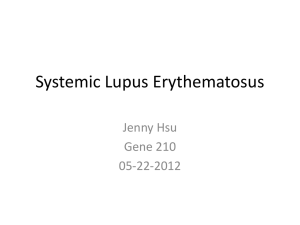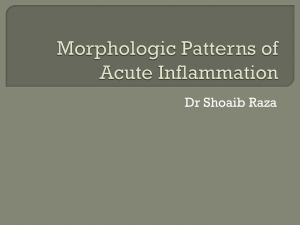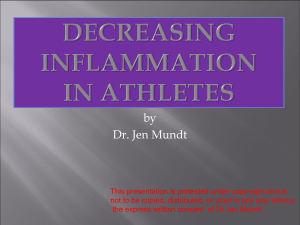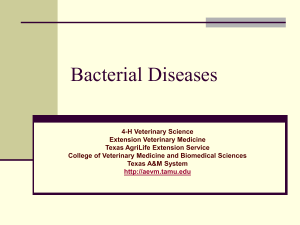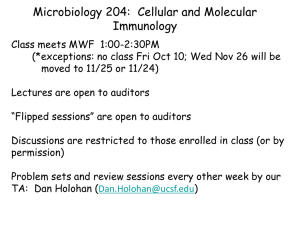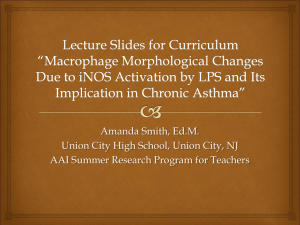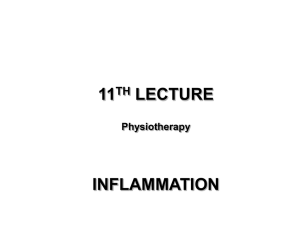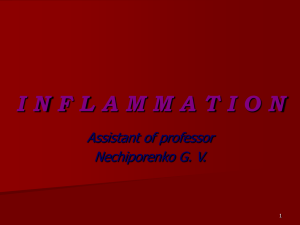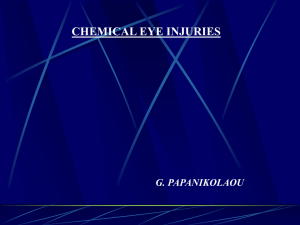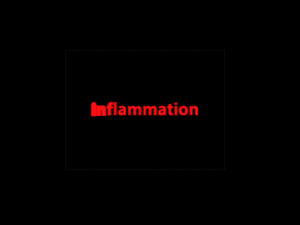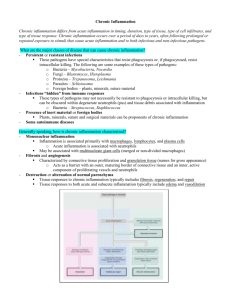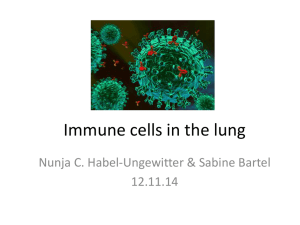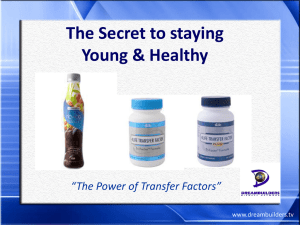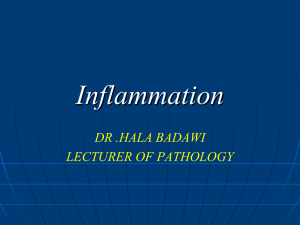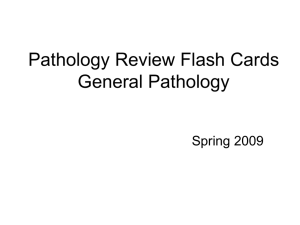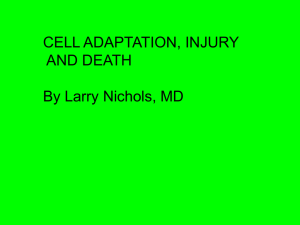Inflammation and Repair
advertisement
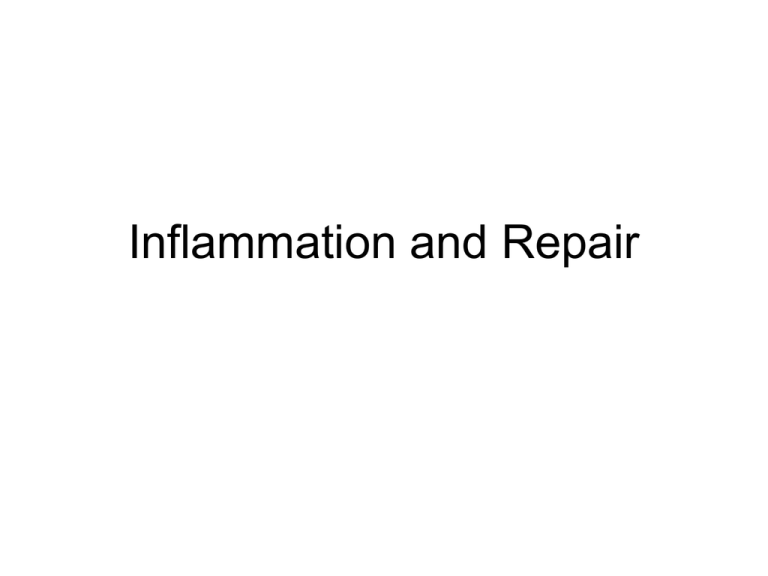
Inflammation and Repair General Vocabulary words • Intracellular space • Extracellular space – Vascular space – Interstitial space • Read Lewis, 318 – 319 – Hydrostatic Pressure – Oncotic Pressure – Fluid Shifts • Edema Capillary Permeability Proteins can only leak out when there is increased capillary permeability Lymphatics • Lymphatic membrane increases in permeability – Allows for greater removal of interstitial fluid – Allows proteins and other substances into the lymph drainage • Possible conduit for spreading infectious or toxic agents Factors Promoting Edema • Increased Hydrostatic pressure – Hypertension – Fluid Overload (Renal, heart, or liver failure) – Increased Venous pressure (PVD, postural blockage) • Decreased Oncotic Pressure – Inhibited Protein production (liver disease, protein malnutrition) – Capillary permeability (local inflammation) • Lymph obstruction Factors Inhibiting Edema • Hydrostatic Pressure – Compression – Drugs reducing fluid volume (diuretics) – Postural • Oncotic Pressure – Colloids (natural or artificial albumin) – Reduce inflammation Factors Affecting Edema Inflammation • Response of surrounding tissue to injury • Allows substances in blood to enter the tissue (due to increased capillary permeability) – Antibodies, Complement, Clotting factors • Purpose – Neutralize and eliminate offending agents – Destroy necrosed tissue – Prepare tissue for reapir Features of Acute Inflammation • • • • • Redness (Erythema) Heat Pain Swelling (Edema) Altered Function Fluid Mechanism of Inflammation • Dilation of local arterioles – Increased local blood flow and pressure • Increase in vascular permeability – Leakage of protein • Viscosity of local blood increases – Blood flow slows down – Allows white blood cells to enter the site of injury Cellular Aspects of Inflammation • Margination and emigration (exit lane) – Allows leukocytes to exit the blood vessels and enter the inflamed tissue – Synonyms: Extravasation, diapedesis • Chemokines (chemoattractants) – Chemicals that attract leukocytes to the site of inflammation – Process is called chemotaxis, gradient driven • Cytokines – Chemicals that alter a cell’s function Chemotaxis and Emigration Inflammation vs Immunity • Inflammation is nonspecific, nonadaptive • Immunity is specific (to select antigens), adaptive • Inflammation allows immunity to happen • Immunity controls inflammation Mediation of Inflammation • Vasoactive amines – Histamine • Plasma enzyme products – Clotting factors, complement, factor XII (Hageman) • Arachidonic acid metabolites – prostaglandins, thromboxanes, leukotrienes • Miscellaneous cell products – TNF, NO, selectins, integrins, ICAM, VCAM, interleukins Mast Cell Histamine Activity Mediation Vocabulary • Cytokine – substance that affects the way other cells function • Zymogen – inactive storage form of an enzyme or other active substance. Examples: – Plasminogen plasmin – Fibrinogen fibrin – Pepsinogen pepsin Leukocytes • Common ancestor – bone marrow pluripotent hematopoeitic stem cell – Common Lymphoid Progenitor • B cells, T cells, Natural Killer Cells – Common Myeloid Progenitor • Erythrocytes, Macrophages, Granulocytes, Dendritic Cells • Progessive differentiation Leukocytes Monocytes-Macrophages • Small quantities in the blood • Spend most of their life cycle in Tissues – Tissue Macrophages may have other names • • • • Liver – Kuppfer Cells Nervous system – Microglial cells Skin – Langerhans Connective Tissue – Histiocytes • Relatively long lived – weeks to months Macrophage Functions • • • • Effector cell Phagocytic Antigen Presenting Common Pathogen Feature Receptors – Glucan, mannose, ligands, LPS • Releases cytokines and chemokines • Granuloma – multinucleated giant cell Antigen Processing and Presentation Dendritic Cells • Not to be confused with dendrites!!! • Relatively new discovery, 1973 • Phagocytic and Macropinocytic – Digest whatever is digested – Recognize digested pathogen features including bacterial DNA, heat shock proteins, and viral RNA • Antigen Presenting Dendritic Cells’ Dual Role • High levels of MHC – present antigens to T cells • At end of life cycle or when activated, migrate to lymph nodes – Activate T cells against pathogenic antigens – Induce Tolerance to self antigens Mast Cells • Unknown blood precursor • Granulated cells – Known to release at least 16 chemokines and cytokines – Best known for Histamine • Major function is to activate inflammation – Membrane Permeability – Leukocyte chemotaxis Granulocytes • Named for cytoplasmic granules – Neutrophils – Basophils – Eosinophils Neutrophils • • • • • Most numerous Shortly lived – 6 hour half life in blood Phagocytic Primarily attack bacterial invaders Bone marrow holds 100 times circulating number of Neutrophils – Segmented Cells (segs) – fully mature – Banded Cells (bands) – slightly immature • Neutropenia Other Granulocytes • Exocytic • Mostly distributed throughout tissues • Eosinophils – Parasites – IgE Allergic reactions • Basophils – Fungus Lymphocytes • Immune cells that control and direct inflammation • Present in small numbers in acute exudates • Large numbers in chronic inflammation • Destroy invaders • Prepare for tissue reparation Lymphocytes • B lymphocyte Plasma Cell antibodies • T lymphocytes – CD8 cells: Cytotoxic (Killer) T Cells – kill viral infected cells – CD4 cells: Helper T Cells (Types I and II) – direct B lymphocytes and macrophages • (CD8 and CD4 are cell membrane proteins) Lymphocyte Life Cycle • Inactive (naïve) lymphocytes circulate through blood and lymph – T cells are activated by dendritic cells (and occasionally macrophages) – B cells are activated by T cells • Once activated, lymphocytes must – Proliferate (replicate, multiply, reproduce) – Differentiate (mature) • Once threat is neutralized – Most undergo apoptosis – A few remain as Memory Cells B lymphocytes • Mature in Bone Marrow (Bone, B, B cell. Get it?) • Naturally produce IgM antibody and display it on their cell membranes (M for Membrane, get it?) • Proliferation and Maturation are directed by CD4 T helper cells • Purpose of maturation is to improve the quality (affinity) of antibody produced Antibodies • Immunoglobulin • Variable region – Somatic hypermutation • C region – Mediates inflammation • Disulfide bonds can be cleaved Immunoglobulin Polymers Antibody Function • • • • • Neutralization Opsonization – “painting” Activation of inflammation Activation of complement Antibody subtypes – IgM – first produced, low affinity – IgD – no known function – IgA – crosses barriers placenta, milk, eyes – IgG – opsonin helps macrophages kill – IgE – eosinophils parasites and allergies T Lymphocytes • During childhood, T cells migrate to Thymus – TCR mutation and tolerance testing – Differentiation marked by CD8 and CD4 protein – CD8 binds to MHC I and marks Cytotoxic cells – CD4 binds to MHC II and marks Helper cells • Further differentiate into Helper I and II cells Activated T Cell Function • Cytotoxic cells – Virally infected cells present viral antigen via MHC I which binds to CD 8 – The cytotoxic cell degranulates into the infected cell, killing it • Helper cells – Direct B cell maturation and Macrophages – TH1 are better at directing Macrophages – TH2 are better at directing B cells Complement Cascade • Consists of 9 zymogens – C1 – C9 • • • • • Three activation pathways All end with C3 convertase Cleaves C3 into C3a and C3b C5 cleaves into C5a and C5b C3b and C5b activate membrane attack complex (MAC) • C3a and C5a act as cytokines and chemokines Figure 2-35 Complement activation pathways • Classical - C1q binds – Directly to pathogen – CRP – Antibody-Antigen complex • Mannose Binding Lectin • Alternative (spontaneous) Complement Functions • Kill Pathogens through MAC – (puncture them and let the guts spill out) • Opsonize pathogens • Mediate inflammation through C3a and C5a Basic Immunophysiology • Three intertwining processes – Inflammation – Adaptive response • Cell mediated • Humoral Non-specific response • Pathogen recognition – Usually begins by recognizing common pathogenic features – Initiates inflammatory response • Brings effector cells to the site • Walls off infection • Prepares tissue for healing Inflammatory Response • Local effects of chemokines and cytokines: especially TNF-α – Vasodilation – Expression of adhesion molecules – Increase in vascular permeability • Leakage of plasma proteins • Clotting factors and complement – Blood clot walls off area from blood supply • Allows dendritic cell time to travel to lymph nodes Inflammatory Response • Systemic effects – TNF-α, IL1-β, IL-6 – Fever • Inhibits pathogen growth • Enhances immune response • Protects body from TNF-α – Acute Phase Response • Acute Phase Proteins released by liver – CRP – MBL – Lung surfactants – Leukocytosis – ↑ESR Septic Shock – TNF-α run amok • TNF-α – Vasodilation – Increases vascular permeability – Induces clotting • TNF-α escapes into blood – Low blood pressure • Vasodilation • Decreased plasma volume from vascular permeability – Disseminated intravascular coagulation (DIC) Adaptive Immunity • Cell Mediated – T Cells – CD8 – Always become cytotoxic T cells – CD4 – Must choose to become TH1 or TH2 • TH1 regulate macrophages – Activate macrophages – Kill infected macrophages – Regulate B cells • TH2 regulate B cells • Humoral Immunity – Antibodies – B cells – become Plasma cells and produce antibodies Memory • Can take a month for full maturation of Plasma cells • Memory cells are fully matured and developed effector cells – Quick response to infections – Suppress naïve immune cells – Do not require co-stimulation Plasma Cells and Memory Immunization • Active – activates body’s immune system against invaders – Goal is formation of Memory cells • Passive – injection of antibodies to offer limited support against an invader Patterns of Inflammation • Time factor – Acute – Chronic • Types of Exudate – Serous (transudates) – Catarrhal (mucus) – Fibrinous (adhesions) – Purulent (furuncle, cellulitis) – Hemorrhagic (hematoma) Inflammation vs Immunity Fate of Inflammatory Reaction • Resolution – Little damage • Repair – Moderate to Severe damage – Regeneration – replacement of parenchyma – Scar formation – replacement of connective tissue • Organization – proliferation of nearby connective tissue into the damaged area • Granulation tissue • Collagen formation • Loss of vascularity Inflammatory Phases Wound Healing – Primary Intention • Incision – Wound formation • Fibrin clot – prevents bleeding, acts as glue to hold skin together • Inflammatory response builds – Blood clot dissolved – Granulation tissue forms where clot was – Epithelium regenerates Wound Healing Secondary Intention • Skin edges cannot be held together • Similar to primary intention – Takes longer – Involves more granulation tissue and regeneration – May form underneath a scab – May show pinpoint bleeding Factors affecting Inflammation • Blood Supply – Elderly, Feet • Bone marrow function • Protein synthesis – plasma and repair – Liver Function – Nutrition • Medication Factors Affecting Wound Healing • • • • • All from slide above Necrotic or foreign tissue in wound Wound infection Excessive movement Dehiscence – breaking open of a surgical wound Dehiscence Hypersensitivity Reactions • • • Damage done to the body as a result of immune reactions Sometimes called allergies Four types of reactions I. II. III. IV. Anaphylactic Cytotoxic Immune Complex Cell-mediated Anaphylactic • Previously called immediate • Requires previous sensitization to antigen – IgE is produced – IgE embeds in basophils and mast cells • Upon subsequent exposure – Massive amounts of histamine released – Vasodilation and increased vascular perm • Systemic – Laryngeal edema, Bronchospasm, seizures, shock Common Anaphylactic • • • • • • • • • Insect stings Penicillin Pollen Animal dander Foods Allergic rhinitis Anigoedema and urticaria Atopic Dermatitis Asthma Cytotoxic • Antibodies bind to antigens on host cells • Host cells destroyed by – Complement – Phagocytes (ADCC) • Common Disorders – ABO blood rejection – Myasthenia gravis Immune Complex • Antibody binds with antigen – Immune complex • Immune complex diffuses out of blood into tissue • Complement cascade activates in the tissue causing inflammation/immune response • Damage is collateral • Disorders: serum sickness, SLE, StevensJohnson syndrome Immune-Complex Cell-Mediated • TH1 cells stimulate Macrophage activity • Macrophages activity causes tissue damage – If antigen is removed, reaction stops – If antigen persists, reaction continues and granulomas may form • Common – Allergic dermatitis: poison ivy, detergents, etc. – Tissue transplant rejection – Tuberculosis Inflammation Tests • Erythrocyte Sedimentation Rates • C-reactive protein: CRP – hs-CRP • • • • Anti-nuclear antibodies (ANA) WBC (with or without differential) Skin tests Ig levels Anti-inflammatory and Anti-immune Drugs • Anti-inflammatories – – – – Inhibit prostaglandin – NSAIDS Inhibit Leukotrienes – asthma drugs Inihibt thromboxane – antiplatelet drugs Antihistamines • Anti-immune – Antiproliferative (Calcineurin inhibitors) – Cytotoxic • Corticosteroids: both, depending on the dose Calcineurin Inhibitors • Calcineurin is needed to produce IL-2 • Without IL-2, T-cells cannot proliferate, so cannot mount an immune response • Used for transplant graft rejection • Drugs Cyclosporine: nephrotoxicity, infection – Kidney, liver, heart transplant – Psoriasis, rheumatoid arthritis • Tacrolimus (FK506): same Cytotoxic Drugs • Kill proliferating B and T cells • Are non-specific: kill all rapidly dividing cells (red blood cells, skin, epithelial cells) • Azathioprine: Adjunct transplant • Cyclophosphamide: cancer, SLE, MS • Methotrexate: cancer, psoriasis, arthritis • Mycophenolate Mofetil: selective, transplant Glucocorticoids used for nonEndocrine purposes • Pharmacologic Actions – Anti-inflammatory and Immune effects • Inhibit prostaglandin, leukotriene, and histamine synthesis • Suppress infiltration of phagocytes • Suppress proliferation of lymphocytes – Effects on Metabolism and Electrolytes • • • • Glucose levels rise Protein synthesis suppressed Fat deposits mobilized Fewer electrolyte effects, but can inhibit calcium absorption Therapeutic Uses • • • • • • • • • • Rheumatoid Arthritis SLE Inflammatory Bowel Disease (IBD) Miscellaneous Inflammatory D/Os Allergic conditions (not acute anaphylaxis) Asthma Dermatologic disorders Neoplams Transplant rejection Preterm infant Immunosuppressive effect • • • • • Cause lysis of activated B and T cells Sequester T cells Reduce IL-2 production Reduce responsiveness to IL-1 Immunosuppressive doses are large, e.g. – Methylprednisolone • Anti-immune doses: • Anti-inflammatory doses: 500 – 1500mg (IV) 5 – 60mg (IV) Glucorticoids Adverse Effects • • • • • • • • Adrenal insufficiency Osteoporosis: long term therapy Infection Glucose intolerance Myopathy F&E disturbance Growth retardation Psychological disturbances Glucorticoids Adverse Effects • • • • Cataracts and Glaucoma Peptic Ulcer Disease Iatrogenic Cushing’s Disease Ischemic Necrosis – especially caution with ETOH Agents • Short Acting – Cortisone, Hydrocortisone Anti-inflammat 1 • Intermediate Acting – Prednisone – Prednisolone – Methylprednisolone – Triamcinolone 4 4 5 5 • Long acting – Betamethasone – Dexamethasone 20-30 20-30
